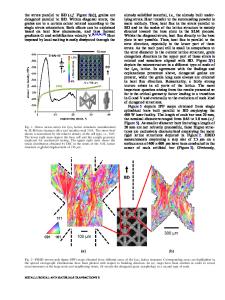Effect of microstructure on
- PDF / 2,102,771 Bytes
- 9 Pages / 597 x 774 pts Page_size
- 39 Downloads / 297 Views
I.
INTRODUCTION
THE need for developing new high-temperature titanium-based alloys has created interest in the creep behavior of titanium aluminides. Titanium aluminides are a family of ordered alloys that form when sufficient amounts of aluminum are alloyed with titanium; these include Ti3A1, TiA1, TiA12, and TiA13. Like many ordered alloys, those based on Ti3AI retain their high strength and modulus values to near the melting temperature m2J due to strong titanium-aluminum bonding. Iz-61It is thought that there is a tendency toward covalency t71in Ti3A1, which contributes to this alloy's main deficiency: its low roomtemperature ductility J Z-6,s-~~ Research efforts which have focused on the steadystate creep behavior of Ti3Al-based aluminides have included investigation of two single-phase a2 intermetallics of composition Ti3A1 (Ti-25AI) and Ti3A1 + 10 (wt pct) niobium (Ti-26AI-5Nb) t~z] which indicated that addition of niobium decreased creep resistance. (All compositions are given in atomic percent unless otherwise indicated.) Steady-state creep rates of Ti-24Al-llNb consisting of 100 pet basketweave a2 were determined. [~2] Other researchers have investigated the creep rates of various microstructures of Ti-25Al-10Nb-3V1Mo. I~3] Their results suggest that colony-type microstructures possessing aligned a 2 laths have the best creep resistance at 760 ~ and from 100 to 200 MPa. It is thought that the slip length in an aligned microstructure is of the order of the colony size when Ti3Al-based alloys are strained at room temperature, ts] Slip character and slip length have been shown to have an important effect on the mechanical properties of titanium aluminidesJ ~41 In a recent review, tm creep resistance of D.E. ALBERT, formerly Graduate Student, Carnegie Mellon University, is Postdoctoral Associate, Institut National Polytechnique de Grenoble, Grenoble, France. A.W. THOMPSON, Professor, is with the Department of Materials Science and Engineering, Carnegie Mellon University, Pittsburgh, PA 15213. Manuscript submitted November 25, 1991. METALLURGICAL TRANSACTIONS A
Ti3A1-Nb alloys was summarized as increasing upon refinement of the Widmanst~itten lath spacing up to some point, after which it decreases. Increasing the amount of retained metastable/3 phase was suggested to decrease creep resistance, and decreased transformed a2 lath spacing caused the effectiveness o f / 3 / a 2 interfaces as creep barriers to be reduced. Steady-state creep of Ti24A1-11Nb was investigated ll61 using the following three microstructures: 100 pct lath a2, 90 pet equiaxed a2, and 40 pct equiaxed a2. The a2 lath structure was seen to be more resistant to diffusional creep than the equiaxed o~2 structure. The addition of niobium to Ti3A1 has been shown to result in an increase in the activity of nonbasal slip vectors. [lvl Prism plane slip with c + a-type activity was reported by Sastry and Lipsitt to be important at higher temperaturesJ ~sl However, Court et al. ~ have shown that an increase in the test temperature of compressed polyc
Data Loading...











